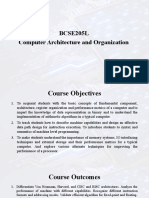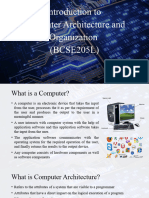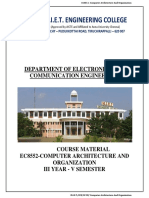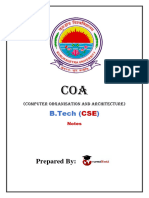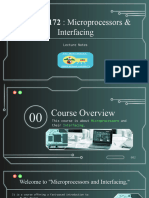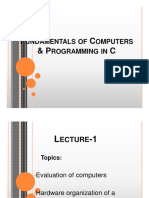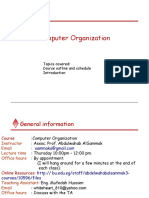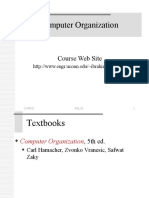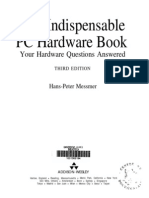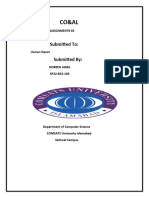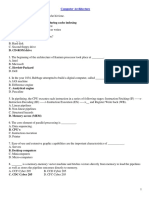Module I
Overview of Computer Architecture
and Organization
What is a
Computer ???
Definition: Cambridge
• It is an electronic machine that is used for
storing, organizing, and finding words,
numbers, and pictures, for doing calculations,
and for controlling other machines
Definition
• It is a fast electronic calculating machine that
– accepts digitized input information
– process it according to a list of internally stored
information and
– produces the resulting output information
Syllabus
Pre-requisites
• Fundamentals of Computer
• Digital Logic Circuits
• Programming Languages (C, C++, Java)
Module 1
• Overview of Computer Architecture &
Organization:
• Introduction of Computer Organization and
Architecture.
• Basic organization of computer and block level
description of the functional units.
• Evolution of Computers, Von Neumann model.
• Performance measure of Computer Architecture.
• Introduction to buses and connecting I/O devices to CPU
and Memory, bus structure.
Module 1
• Overview of Computer Architecture &
Organization:
• Introduction of Computer Organization and
Architecture.
• Basic organization of computer and block level
description of the functional units.
• Evolution of Computers, Von Neumann model.
• Performance measure of Computer Architecture.
• Introduction to buses and connecting I/O devices to CPU
and Memory, bus structure.
Module 2
• Data Representation and Arithmetic
Algorithms:
• Number representation: Binary Data
representation, two’s complement representation
and Floating-point representation. IEEE 754 floating
point number representation.
• Integer Data computation: Addition, Subtraction,
Multiplication: Signed multiplication, Booth’s
algorithm, Division of integers: Restoring and non-
restoring division, Floating point arithmetic:
Addition, subtraction
Module 3
• Processor Organization and Architecture:
• CPU Architecture, Register Organization , Instruction formats,
basic instruction cycle. Instruction interpretation and
Sequencing.
• Control Unit: Soft wired (Micro-programmed) and hardwired
control unit design methods. Microinstruction sequencing
and execution. Micro operations, concepts of nano
programming.
• Introduction to RISC and CISC architectures and design issues.
• Case study on 8085 microprocessor: Features, architecture,
pin configuration and addressing modes.
Module 4
• Memory Organization:
• Introduction to Memory and Memory
parameters. Classifications of primary and
secondary memories. Types of RAM and ROM,
Allocation policies, Memory hierarchy and
characteristics. Cache memory: Concept,
architecture (L1, L2, L3), mapping
• techniques. Cache Coherency, Interleaved and
Associative Memory Virtual Memory:
Concept, Segmentation and Paging , Page
replacement policies.
Module 5
• I/O Organization and Peripherals:
• Input/output systems, I/O modules and 8089
IO processor.
• Types of data transfer techniques:
Programmed I/O, Interrupt driven I/O and
DMA.
• Peripheral Devices: Introduction to peripheral
devices, scanner, plotter, joysticks, touch pad.
Module 6
• Introduction to parallel processing systems:
• Introduction to parallel processing concepts
• Flynn’s classifications
• pipeline processing
• instruction pipelining,
• pipeline stages
• Pipeline hazards.
Text Books
• 1. Carl Hamacher, Zvonko Vranesic and Safwat Zaky,
“Computer Organization”, Fifth Edition, Tata McGraw-
Hill.
• 2. John P. Hayes, “Computer Architecture and
Organization”, Third Edition.
• 3. William Stallings, “Computer Organization and
Architecture: Designing for Performance”, Eighth
Edition, Pearson.
• 4. B. Govindarajulu, “Computer Architecture and
Organization: Design Principles and Applications”,
Second Edition, Tata McGraw-Hill.
Reference Books
• 1. Dr. M. Usha, T. S. Srikanth, “Computer
System Architecture and Organization”,First
Edition, Wiley- India.
• 2. “Computer Organization” by ISRD Group,
Tata McGraw-Hill.
• 3. Ramesh Gaonkar, “Microprocessor
Architecture, Programming and Applications
with the 8085, Fifth Edition,Penram.
Termwork
• Term work should consist of at least 08 experiments.
• Journal must include at least 2 assignments.
• The final certification and acceptance of term work ensures
that satisfactory performance
• of laboratory work and minimum passing marks in term work.
• Term Work: 25 Marks ( total marks ) =
– 15 Marks ( Experiment ) +
– 5 Marks ( Assignment ) +
– 5 (Attendance (theory+practical))
• oral exam will be based on the above syllabus.
My Computer
Lenovo Desktop
• Name & Model : Intel Core i3-2120
• CPU Speed : 3.3 GHz
• RAM : 2GB
• 32-bit Operating System
• Hard disk : 320GB
HOW MANY CORES ARE IN YOUR MOBILE?
Micro architecture
• It is a description of the electrical circuitry of a
computer central processing unit that is
sufficient for completely describing the
operation of the hardware.
Types of Computers
• Desktop & Mobile
• Notebook
• Workstations
• Mainframes
• Servers
• Supercomputers
DESKTOP COMPUTERs
• It has
– Processing & Storage units(e.g. Hard disks, CD‐
ROMs),
– visual display &audio output units,
– Input units ( keyboard, mouse, etc)
• It can be easily located on a home or office
desk
• Used in homes, schools, business offices,…
NOTEBOOK COMPUTERs
• Compact form of personal computer (laptop)
• Size of a thin briefcase
• Portable
WORKSTATIONs
• Has high resolution graphics input/output
capability
• Has dimensions of desktop computer
• More computational power than PC
• Costlier
• Used to solve complex problems which arises in
engineering application
Mainframe
• Also called Enterprise Systems
• More computational power and storage than
Workstation
• Used for business data processing in medium
to large corporations.
Servers
• Contain big database storage units.
• Handles large volumes of data requests
• Requests and responses are transported via
Internet
• They are widely accessible to all.
Supercomputers
• Faster than mainframes
• Helps in large scale numerical calculations
• Used for aircraft design and testing, military
application, weather forecasting, etc.
Quiz
Question : 01
• The acronym PC stands for:
A. Private Computer
B. Personal Computer
C. Personal Compact
Question : 02
• Complex scientific research is usually done
using:
A.Mainframe Computer
B.Super Computer
C.Mini Computer
Question : 03
• A laptop is an example for Personal Computer
A.True
B.False
Question : 04
• Which is not a Personal Computer
A.Desktop
B.Laptop
C.Mainframe
D.Tablet
Question : 05
• Mainframes are very cheap
A.True
B.False
This course is about:
• What computers consist of
• How to fix computers
• How computers work
• How to build myself one
• How they are organized real cheap
internally
• Which one to buy
• What are the design tradeoffs
• Knowing all about the
• How design affects core i3, i5, i7
programming and applications
Introduction of Computer
Architecture and Organization
University Question
• Differentiate between Computer
Architecture and Organization (05 Marks)
Computer Architecture
• Defn: It refers to the attributes of a system
visible to a programmer that have a direct
impact on the logical execution of a program
• E.g. : Instruction set, No. of bits for various
datatypes,…
Computer Organization
• Defn: It refers to the operational units
and their interconnections that realize the
architectural specifications.
• E.g. Interfaces, Memory Used,…
Example
Architectural Issue Organizational Issue
• Whether to have • Whether to
multiply include a multiply
instruction? unit or go for
repeated
addition?


